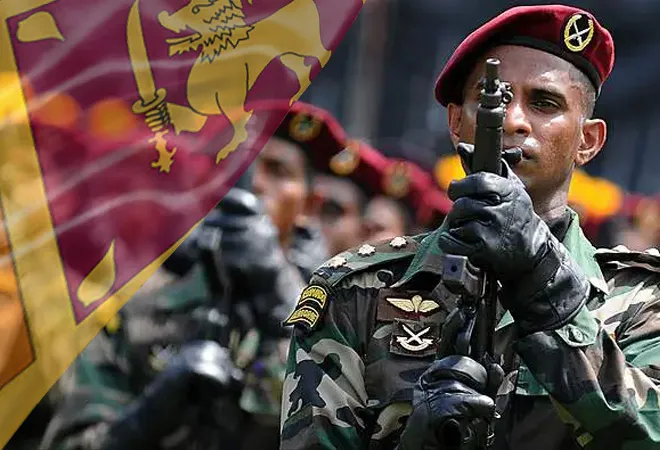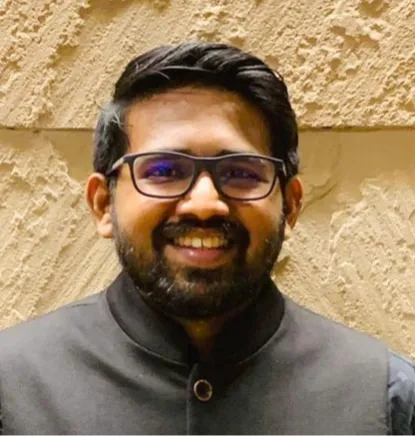
As Sri Lanka embarks on its path to economic recovery, it is
re-assessing its defence and security posture. Following its civil war, Sri Lanka has continued to spend significantly on its security forces and defence. However, with the onset of the economic crisis, there is a growing realisation that higher military spending has
contributed to lower investment and economic growth. There is a strong
demand to reduce the military size,
promote procurement and capacity building, and
build a technically and tactically well-equipped force to meet future security challenges. It is
expected that the military strength will be reduced to 135,000 by 2024 and to 100,000 by 2030. These reforms will have an impact on Sri Lanka’s defence relationships and might offer India an opportunity to heighten its partnership.
Understanding the expenditure
In the aftermath of the final phase of the Eelam War (2006-2009), Sri Lankan armed forces have embraced a defensive and peacekeeping (or peace enforcement) role in the country. The number of total military personnel has increased since the end of the civil war (Table 1), and the budget allocation and defence spending (% of GDP) hasn’t seen any significant decline either. The budget allocation for defence continued to stay higher than in the civil war years with some minute fluctuations till the economic crisis in 2022. Its defence spending has also fluctuated around
2 percent since 2015, contributing to significant government expenditures. In 2017 alone, the defence spending summed
up to 11 percent of the government’s expenditure.
Table 1. Sri Lanka’s defence budget, spending, and military personnel
| Year |
Budget allocation for Defence (in USD billion) |
Defence Spending % of GDP |
Total Military Personnel |
| 2008 |
1.54 |
4.15% |
150,900 |
| 2010 |
1.86 |
2.85% |
160,900 |
| 2013 |
1.82 |
2.79% |
160,900 |
| 2015 |
1.85 |
2.33% |
160,900 |
| 2016 |
1.96 |
2.38% |
243,000 |
| 2017 |
1.70 |
2.04% |
243,000 |
| 2018 |
1.74 |
1.88% |
243,000 |
| 2019 |
1.67 |
1.93% |
255,000 |
| 2020 |
1.59 |
1.96% |
255,000 |
| 2021 |
1.53 |
1.89% |
255,000 |
| 2022 |
1.15 |
1.97% |
255,000 |
Source: IISS
A variety of factors have contributed to this sustained spending and expenditure. The military’s popularity and nationalism, coupled with unemployment and the need for economic and overall security has continued to
feed into the increasing number of military personnel. Further, the government’s unwillingness to
review the national security situation, lack of understanding of strategic means and ends, high corruption, and the military’s involvement in business ventures, construction and development activities have contributed to this unsustainable allocation and expenditure. These factors have been complicated by the country’s nationalist politics, the military’s popularity and legitimacy, and significant overlapping between the army and the polity. The army continues to
hold key positions in the country’s civil administration and is often subjected to additional powers when dealing with crises, as seen during the COVID-19 pandemic and the economic crisis.
However, a crucial reason for such expenditure is the persistent militarisation of the country. Despite the end of the civil war, grievances and reconciliation of Tamils remain unaddressed. The Sinhala nationalists see the militarisation of Tamil regions as the only solution to sustain peace in the country. They have remained sceptical of de-militarisation. Today, 14 out of 21
army divisions continue to be deployed in the Tamil-dominated northern parts of the country.
In some districts, this ratio exaggerates to one soldier for every two civilians. More often than not, the military occupies lands, runs businesses, and overlooks civil administration in these regions.
Nurturing defence partnerships
This militarisation has often run in contrast with India’s interests. In Sri Lanka, India has often
furthered a cause for equality, peace, reconciliation and
democracy. In addition, India has also championed the cause
of full implementation of the 13th Amendment—meaning that Colombo will have to offer more land and police powers to provinces. This is a demand that Sri Lanka has hesitated to implement, fearing that a weak command over lands and law and order would lead to more secessionist tendencies. Recently, even President Wickremesinghe failed to meet the deadline for the complete implementation of the
13th Amendment.
The government’s unwillingness to review the national security situation, lack of understanding of strategic means and ends, high corruption, and the military’s involvement in business ventures, construction and development activities have contributed to this unsustainable allocation and expenditure.
This militarisation of Tamil regions has thus kept India away from robustly expanding defence exports to the island nation. In comparison to China and other countries, India’s defence exports are significantly lower in Sri Lanka (Table 2). Even in terms
of equipment, India has hesitated to offer offensive weapons and has rather provided vehicle engines, patrol vehicles, and air search radars to Sri Lanka.
That said, India and Sri Lanka still enjoy a steadily increasing defence partnership. They hold bilateral exercises such as Mitra Shakti for the army, SLINEX for the navy, and a trilateral coastguard exercise called Dosti with the Maldives. India’s strength in defence cooperation is its capacity-building and military training.
In 2019, it offered 344 training courses for the Sri Lankan military, while China hosted only 86 courses.
In 2021, India again hosted over 308 training courses for the former. Colonial legacy and institutional similarities have continued to lure Sri Lankan personnel to choose India as their first training destination. Over
60 percent of Sri Lankan military personnel pursue young, junior and senior command courses in India. New Delhi has continued with these training programmes despite the political pressure from
Tamil Nadu to revoke them.
Table 2. Arms exports to Sri Lanka
| Country |
Total Arm exports in million $ (1950-2023) |
| China |
756 |
| Israel |
490 |
| USA |
304 |
| Ukraine |
214 |
| Russia |
190 |
| UK |
145 |
| India |
140 |
Source: SIPRI
On the other hand, China’s defence cooperation with Sri Lanka expanded during the final phase of the Sri Lankan civil war. In
the 1970s, China provided Sri Lanka with transport and patrol crafts, armed infantry vehicles and carriers, and towed guns. But, during the final phase of the war, it began to
offer air radar systems and offensive weapons like fighter jets and air-to-air missiles. In addition, China also offered military assistance worth US$
35 million when most countries hesitated to support Sri Lanka. This defence cooperation further strengthened the bilateral relations between both countries. Today, China is the largest arms exporter (Table 2) to Sri Lanka, worth over US $756 million.
Following the civil war, China and Sri Lanka’s defence cooperation expanded to different sectors. Chinese warships and submarines began making port calls, and in
2012 – a Chinese Defence Minister visited Sri Lanka for the first time. Both countries have also conducted joint
Humanitarian and Disaster Response operations, joint counter-terrorism training, and
joint exercises like the Cormorant strike. They have also signed a military assistance protocol agreement and a strategic cooperation partnership agreement. China’s interest in defence partnership has
increased with its investments in Sri Lanka and its competition with India and the rest of the
QUAD members.
Reforms and stakes for India
To date, India and China have enjoyed distinct advantages and challenges when pursuing defence cooperation with Sri Lanka. However, Sri Lanka’s quest for right-sizing the military and building a well-equipped force for future challenges offers opportunities for India to further expand its partnership. India is at an advantage for the following reasons: one, it has already taken a lead in Sri Lanka, and two, the reforms will in part eliminate its export dilemma.
Sri Lanka’s quest for right-sizing the military and building a well-equipped force for future challenges offers opportunities for India to further expand its partnership.
With the onset of the economic crisis, China made no efforts to boost Sri Lanka’s defence capabilities. Beijing last offered a frigate to
Colombo in 2019. But India has taken a proactive interest in promoting Sri Lanka’s naval capabilities. It has
agreed to offer two Dornier surveillance aircraft, build a floating dock facility, and
set up a Maritime Rescue Coordination Centre in Sri Lanka. India has also
included Sri Lanka in the Information Fusion Centre-Indian Ocean Region (IFC-IOR). Further, as Sri Lanka’s stance on reforms became clear, India has attempted to promote capacity-building and capital expenditure of the military. Essentially, New Delhi has begun negotiations to
increase training cooperation and
establish a small manufacturing plant in Sri Lanka. India also held its first-ever
defence exhibition in June 2023. It is expected that these initiatives will reduce Sri Lanka’s dependence on others for defence imports, and also promote a closer relationship with India.
Secondly, the reduction of the number of military forces should, in part, eliminate New Delhi’s dilemma over defence exports. As Sri Lanka right-sizes its military, it will adversely impact the country’s militarisation and the military’s role in development and administration. Thus, paving the way for democracy, civilian administration, and reconciliation. In other words, these reforms will address some of India’s concerns in Sri Lanka. Such reforms will also enable India’s key partner, the United States (US), to increase its defence cooperation with Sri Lanka since calls for
accountability and reforms had often limited the extent of these interactions.
The downsizing of the military should thus be seen as a positive development. India already has an advantage in the island nation to further elevate a defence partnership. Its interests, pre-existing defence relations, and capacity-building initiatives, along with the US’s defence technology, has the potential to help Sri Lanka carve out a technically and tactically well-equipped force.
Aditya Gowdara Shivamurthy is a Junior Fellow with the Strategic Studies Programme at the Observer Research Foundation
The views expressed above belong to the author(s). ORF research and analyses now available on Telegram! Click here to access our curated content — blogs, longforms and interviews.



 As Sri Lanka embarks on its path to economic recovery, it is
As Sri Lanka embarks on its path to economic recovery, it is  PREV
PREV


